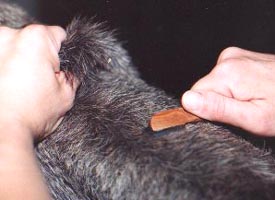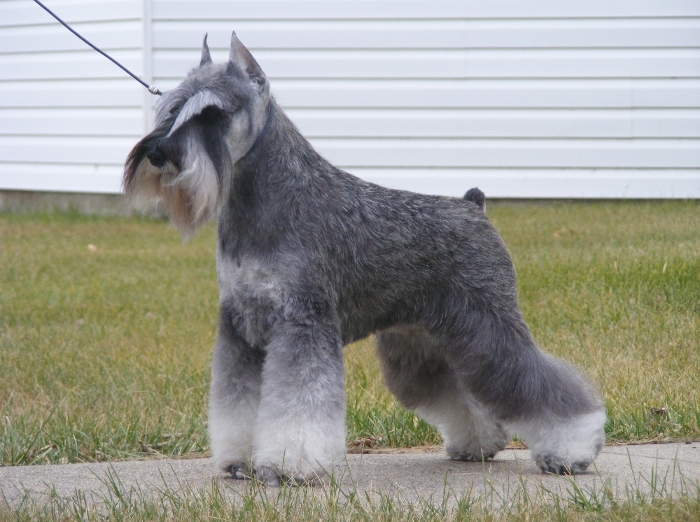Starting Out
When beginning with a puppy, start by pulling off the wispy guard hairs at about 3 months of age. (In an adult, it is preferable to start as the coat begins to blow). Pull coat at random from all the areas that will form the pattern of the jacket. This includes the skull to the zygomatic arch, the tail, throat and ears if uncropped. (I usually clipper cropped ears). The stripping pattern should extend deep on the ribcage to the nipples behind the elbows.
Work once a week, raking the undercoat and pulling more hair at random. It
matters not which hairs you pull, just try to take them in equal number from the entire
jacket. On faster growing coats, you will aim for the removal of about 1/8th of the coat for 8
weeks. On slower ones, stretch the pulldown time to 10 weeks.
After a month or so of this,
the coat will be looking very ragged and patchy. This is normal! Resist the urge to tidy it
with shears. Just do minimal clippering in the appropriate areas. The front of the throat is
not an appropriate area! This should be stripped, no matter how awkward. Rule of thumb: If it
isn't white in color, pull it out.
When the gradual pulling down is nearly complete, you
will have a confusion of undercoat and scraggly wire appearing. This is not the real jacket,
but the remnants of hairs cut. Strip the remainder of this junk off as the new wire emerges.
Working the New Jacket
As the first coat appears, work it immediately, lightly pulling some off as soon as it can be grasped. Continue to pull on this new coat weekly, varying the rate of removal to allow for areas that need fill or flattening. Resist any temptation to leave a low spot completely alone...all areas must be worked weekly. The hair you are pulling is the seed planted for your jacket 12 weeks in the future. Leaving low spots to grow now will leave barren ground to deal with later.
It can take two complete rotations of a new jacket (20 weeks) to set a consistant, competitive coat. However, your perseverance will be rewarded. A rolling jacket can be sculpted without leaving tell-tale color patches. Tan and cinnamon shades are greatly reduced as the trauma to the hair follicle is less. (This shading seems to be caused by chemical changes brought about by hard stripping. The gentler rolling process tends to reduce this effect.)
Note: after some time in a rolling jacket, a few dogs will cease growing or have greatly reduced volumes of undercoat. The reason for this isn't clear.
Now, the Details
Just about anyone can get throught the previous steps with some success. It is in the attention to detail that sets apart the quality rolling jacket at the highest levels of competition. One advantage of the full stripped, patterned jacket is that you can get away with "cheating" with the use of thinning shears, edges are tidied, areas flattened, etc.
|
Hide them. You do not own any. Their use will cause more long term harm and set back your work by months. All of your blending and sculpting must be by hand. |

|

You must rake vigorously, so hold the skin tightly to prevent pinching and abrasion to the dog. Watch for irritation - for this reason, rake at least 48 hours prior to a show in case irritated areas need to settle.
Consult the mirror constantly when working coats or doing any trimming. Stack the dog frequently and check your progress. Areas of patchy color indicate uneven work. Pick at dark areas with your fingertips while watching in the mirror, to blend them away.
Maintenance
Monday or Tuesday is the ideal time for pulling of the weekly layer. If
you've a gap in your show schedule, you must still work the coat weekly.
You don't need to be particular, but don't think you can let a coat go for a
few weeks and catch up later. You must continue by pulling down each
layer just as it reaches ideal length - no longer. This will keep
the coat in prime condition.
Removal of topcoat when in prime length becomes easier with experience.
Brush the surface lightly with your thumb as you grasp the tips of hair.
Do not bother with the practice of rolling the skin to spread the hair
in an effort to identify the longest ones. Work the coat in it's nautral
position. Monitor your work with one eye on the mirror, one on the coat
surface. Work on creating clean outlines, sharp detail and even color
distribution.
Should you happen to get behind for whatever reason, do not make the mistake of doing a major pulldown. This will destroy the careful timing between the layers, leading to a surge of coat in the future. Work an overgrown coat as usual, but tighten up your timing to 5 day intervals or so until back to the correct length, then resume weekly stripping.
Black jackets are more forgiving of mistakes, but they can fool the eye into leaving uneven lengths. Undercoat removal is critical if it is not as black as the topcoat. Detail areas must be constantly attended to as overwork will leave obvious bare spots. (It is also strongly recommended that you strip some coat from the cheeks, chest, stern and ears periodically to help maintain the color on these areas.)
You must NEVER bathe the salt and pepper rolling jacket.. Your coat work removes dirt anyway and dust can be rubbed out with alcohol. Black coats show more dust and dandruff that cannot always be removed this way, so when absolutely neccessary, use a tar-sulpher shampoo sparingly and blow dry while combing in the direction of the hair.
The finished product!
The "imposters"
Don't be turned off if someone describes a junky, motheaten coat as "rolling". These are evidence of improper technique or texture - nothing more. A good rolling jacket is nearly indistinguishable in quality from a patterned one. It takes closer examination of the hair lengths to tell the difference.
There are some coat types that never roll well. Sparse, silky, weedy wire that doesn't have enough follicles to provide good coverage - but now that you're a "purist" you will have likely found a pet home for those ones anyway!
